
Starfish or sea stars are star-shaped echinoderms belonging to the class Asteroidea. Common usage frequently finds these names being also applied to ophiuroids, which are correctly referred to as brittle stars or basket stars. Starfish are also known as asteroids due to being in the class Asteroidea. About 1,900 species of starfish occur on the seabed in all the world's oceans, from warm, tropical zones to frigid, polar regions. They are found from the intertidal zone down to abyssal depths, at 6,000 m (20,000 ft) below the surface.
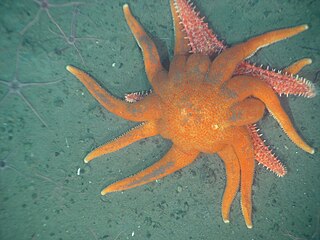
The Valvatida are an order of starfish in the class Asteroidea, which contains 695 species in 172 genera in 17 families.

Protoreaster nodosus, commonly known as the horned sea star or chocolate chip sea star, is a species of sea star found in the warm, shallow waters of the western Pacific ocean. They are sometimes seen in the marine aquarium trade or dried and sold as curios.

Patiriella regularis, or New Zealand common cushion star, is a sea star of the family Asterinidae, native to New Zealand. It has an arm spread of up to 60 mm (2.4 in).

Parvulastra exigua, or the dwarf cushion star is a species of sea star in the family Asterinidae. It can be found in temperate intertidal marine communities from geographically widespread sites around the southern hemisphere.
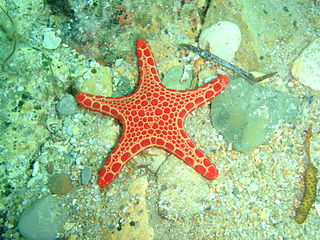
Goniasteridae constitute the largest family of sea stars, included in the order Valvatida. They are mostly deep-dwelling species, but the family also include several colorful shallow tropical species.

Meridiastra mortenseni is a sea star of the family Asterinidae endemic to New Zealand. Discovered as a new species in 2002, it is named after T. Mortensen, who recorded it as distinct from Patiriella regularis, the New Zealand common cushion star, in 1925. Genetic evidence moved P. mortenseni from the Patiriella genus to Meridiastra in 2004.

Culcita is a genus of cushion stars. They are found in tropical waters. Some are kept in home aquariums.

The Forcipulatida are an order of sea stars, containing three families and 49 genera.

Patiria miniata, the bat star, sea bat, webbed star, or broad-disk star, is a species of sea star in the family Asterinidae. It typically has five arms, with the center disk of the animal being much wider than the stubby arms are in length. Although the bat star usually has five arms, it sometimes has as many as nine. Bat stars occur in many colors, including green, purple, red, orange, yellow and brown, either mottled or solid. The bat star gets its name from the webbing between its arms, which is said to resemble a bat's wings.
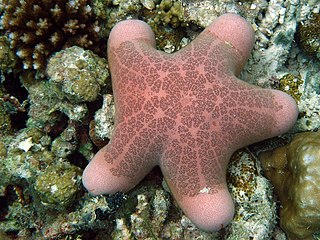
The Oreasteridae are a family of sea stars in the class Asteroidea.

Protoreaster is a genus of sea stars in the family Oreasteridae from the Indo-Pacific. They are sometimes seen in the marine aquarium trade.
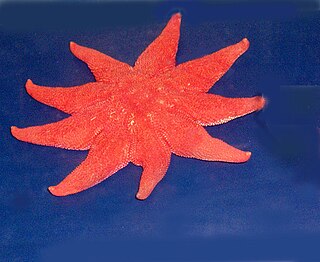
Solaster is a genus of sea stars in the family Solasteridae.

Pteraster tesselatus, the slime star or cushion star, is a species of starfish in the family Pterasteridae found in the North Pacific.

Cryptasterina hystera is a species of starfish. It is found in a limited region of the coast of Australia and is very similar in appearance to Cryptasterina pentagona. The two appear to have diverged from a common ancestral line a few thousand years ago.

Pentaceraster cumingi, sometimes known as the Panamic cushion star, Cortez starfish or knobby star, is a species of starfish in the family Oreasteridae. It is found in warmer parts of the East Pacific and in Hawaii. In Panama this species has been collected from the Pearl Islands, Gulf of Panama, and off Coiba Island, Gulf of Chiriqui. It reaches a diameter of about 30 cm (12 in).
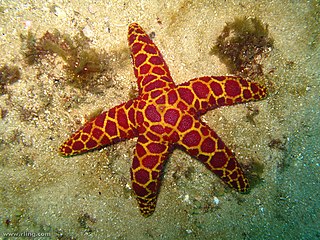
Plectaster decanus, the mosaic sea star, is a species of sea star found off the south coast of Australia. It is the only species in the genus Plectaster.
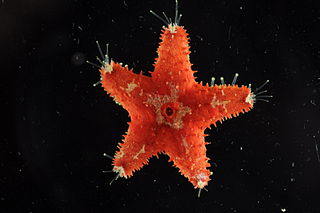
Euretaster insignis, commonly known as the striking sea star, is a species of starfish in the family Pterasteridae found in the central west Pacific Ocean. It is one of only three species in the order Velatida to be found in shallow water in the tropics. The young are brooded in a cavity underneath a "supradorsal" membrane.

Protoreaster lincki, the red knob sea star, red spine star, African sea star, or the African red knob sea star, is a species of starfish from the Indo-Pacific.



















